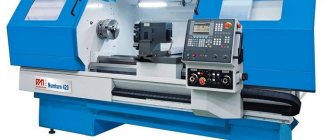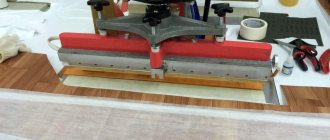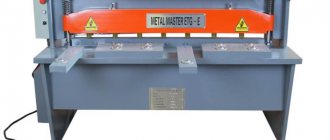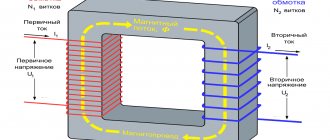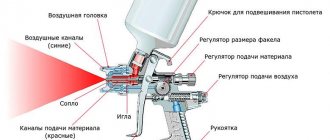Metal bending is a technology for changing the shape of a sheet metal blank.
The technological process of bending metal sheets is considered one of the most popular in the production of metal structures. In this way, clamps, ebbs, extensions, ridges, roofing elements, and parts for metal structures are manufactured. In order to bend such a hard material as metal, you need a sheet metal bending machine.
Design and scope of application of sheet metal bending machine
Machines for bending sheet metal are used in home workshops and factories. The devices have the same operating principle. Only the drive type changes. Bending machine design:
- The base that holds the desktop, movable mechanisms. This applies to models that are not fixed to workbenches.
- Pressing flywheels that hold the part during operation. Usually they are a metal plate.
- A wooden beam that acts as a cushion that acts as a support for the workpiece.
- Protractor for setting the desired angle.
- Stops limiting the sheet at the front and back.
Sheet benders are equipped with a special knife for cutting metal sheets. It is a separate tool that is mounted on the machine. The craftsman needs to make an effort to move it across the entire width of the workpiece. Sharp discs will cut thin sheet material to the specified size.
Sheet bending machines are used in various areas of industry:
Metal bending
The required result is obtained through metal deformation technology. When bending, the inner layer of the material is compressed and the outer one is stretched. In some ways, the bending operation is akin to straightening, the use of which eliminates defects - convexities and waviness.
Why do we need bending machines?
There is sheet metal.
And there are various profiles - bent sheet metal of the most varied shapes and purposes such as gutters, ridges, cornices and other roofing profiles. The difference in cost of sheet material and finished bent parts varies several times. Therefore, bending sheets yourself is a profitable business from an economic and professional point of view. When it is profitable not to buy, but to do it yourself - a rather rare situation in the modern technical world with the narrow specialization of any production.
Bending profiles on a machine.
Simplicity of execution, high productivity and cost-effectiveness are an excellent combination of advantages that homemade bending equipment of various types has.
Let's understand and put in order information on metal “bending” issues and ways to solve them.
Types and design of bending machines
Bending of sheet metal is carried out using specialized equipment - sheet bending machines. According to the operating principle, metal bending machines can be divided into several types:
Universal bending machine
Universal. When this machine operates, the sheet is placed in a fixed matrix and, with the assistance of a punch, it is given the required shape. Punches are made in several designs, which differ from each other in shape and size, for example, in angle. As a rule, a groove in the shape of an angle is made on the matrix.
Universal presses are easily reconfigurable and can solve many technological problems.
Turning. This machine consists of a traverse, as the bending beam is called, a bending beam and a back stop. A clamping beam is necessary to secure the sheet of metal to the frame. The bending of the sheet is carried out by a bending beam. In fact, it is the main working element of this machine.
Rotary bending machine
Rotary bending machine
Rotary. The design of such equipment may include several shafts (rolls). They rotate around their axis. In addition, the work rolls can move in a vertical plane. A sheet of metal is placed in the space between the shafts and by moving them vertically the future bending radius is adjusted. After the sheet passes between the rotating shafts, it receives the required shape.
A metal bending machine can be powered by human muscle power, hydraulic, pneumatic, electric (electromechanical) or mechanical drive.
Folding machine
Folding machine
To work with metal of small thickness, folding or folding machines are used. They are widely used when working with roofing sheets, creating ventilation ducts, etc.
Schemes and purpose
Listogib is a rather general concept. The design of a sheet bender depends on its purpose. According to the nature of the work, you need to choose a homemade scheme, see fig.
Schemes of operation of sheet bending machines of various types
At pos. A - a method familiar to everyone who has done at least a little plumbing. This way you can simply bend sheets up to 0.5 m wide by hand. If the bend length is no more than 200-250 mm, then the base can not be attached to the workbench, but together with the pressure beam and the part can be clamped in a vice. The bend turns out well if you press the traverse more low, as shown in the force diagram, and move it slightly forward, as if smoothing the bend. Most designs of homemade sheet bending machines are based on this principle; we'll get there yet.
Due to the elasticity of the metal, it is not possible to bend the sheet exactly 90 degrees, so spacers made from a strip of metal are used, as shown in the inset. Why are there channels on the cut and not corners? Next we will consider this issue; The seemingly simple design has significant nuances.
Pos. B shows how a press brake works. Press like a press: bed-die-punch-hydraulics-impact-ready. These are used only in industrial production with a developed labor protection system: they are complex, expensive, require qualified care and are extremely dangerous. A sheet that slips due to improper filling or equipment malfunction can cut off a person’s hand or head.
At pos. B – broaching (pass-through) sheet bending machine. By changing the relative position of the rolls, you can set the bending radius of the sheet. The walk-through sheet bender can be either manual or electrically driven. Those that go on general sale are usually multifunctional:
- Smooth rolls are intended for tinsmithing work - bending blanks for casing shells, sections of wide pipes, etc.
- The rollers can be replaced with complete profiled sheet-bending rollers designed for pulling roof extensions - ridges, valleys, gutters and flanges.
- Also, many models are equipped with a support, a clamp and a traverse for manual bending of sheets.
These are the kind of sheet metal benders that sell for $2000 or so. Many are equipped, or can be purchased later, with shaped rollers for corrugated sheeting, but, as has already been discussed, you cannot “drive a shaft” for sale on them. You can roll a piece if you need it now, but there is no point in buying a whole sheet.
Types of bending machines
To get a complete picture of how a sheet bending machine works, you need to understand how it works. This equipment includes components such as a table on which workpieces are placed. The workpiece will move along its surface in a given direction. In addition, a cutter can be installed on the table, cutting off the finished parts from the sheet of source material. A roller knife or saber guillotine can be used as a cutter.
Bending machine
The bending machines include a protractor. It is used to set the angle at which the sheet should be bent. In addition to this unit, limiters that regulate the maximum height of the resulting product play an important role. The working bending length and maximum metal thickness for each type of machine are strictly individual.
In practice, the following types of bending machines are used.
Manual metal bending equipment
Manual equipment is small in size and can be easily transported from one place to another. It is used in single production. Manual machines are used to produce parts made of different materials, for example, aluminum, copper, galvanized steel. Operating such a machine does not require any special training.
Electromechanical equipment for metal bending
Mechanical equipment uses the energy of a flywheel in its operation, which is spun specifically for this purpose. Machines with an electromechanical drive operate through a drive station, which includes an electric motor, gearbox, belts or chains. Hydraulic units operate from energy received from a hydraulic cylinder.
Hydraulic sheet bending machines
By the way, for gentle bending of sheets, especially those coated, sheet benders using compressed air are used. There are also devices such as electromagnetic ones. They are quite often used in the manufacture of boxes and boxes. The working tools in such equipment are powerful electromagnets, under the influence of which the sheet bends.
A separate class of bending equipment is portable (mobile); as a rule, they are used directly in the workplace, for example, on a construction site.
Types of sheet benders
Bending machines are divided according to various factors. Depending on the type of drive, the following types of equipment can be distinguished:
- Manual - models installed in private workshops and enterprises. They consist of a pressure plate, a work table, and a bending mechanism that works after transmitting human force through special handles. To work with the equipment you do not need to have additional skills.
- Mechanical - structures that consist of a flywheel, a moving shaft, and pressure plates. To bend the workpiece, you need to spin the flywheel.
- Hydraulic - a system that operates using fluid. Under pressure, it begins to act on a hydraulic cylinder, which bends the sheet.
- Electromechanical - consists of an electric motor, which, using belts and a set of gears, transmits force to a clamping bar, a moving mechanism. Allows you to bend workpieces of large thickness.
- Pneumatic - mechanisms operating using pneumatic cylinders.
- Electromagnetic - modern equipment on which high-power electromagnets are installed. After turning on the machine, they begin to move the bending bar to the specified angle.
Compact models of sheet benders should be included in a separate group. They can be used on a construction site. The downside is the insufficient size and power, which does not allow bending sheets of large sizes and thickness.
Manual sheet bending machine
Advantages and disadvantages of bending machines
Like any bending equipment, it has a number of advantages. These include the strength of the resulting finished parts. The use of bending machines allows you to form parts without the use of welding and cutting. After the bending operation is completed, the likelihood of corrosion phenomena occurring at the site where it is performed is reduced.
Calculation of bending force allows you to create a durable product
The use of bending machines makes it possible to create integral structures, and as part of such a product it is possible to obtain versatile bends and angles. But you also need to understand that bending equipment is quite expensive. Sheet bending operations are highly labor-intensive, especially if this work is performed on equipment designed for manual work. But the listed shortcomings are more than compensated by the quality of the resulting products.
How different types of devices work
With the help of modern technologies, it is possible to transform metal blanks of different sizes into high-quality products of the required configuration. Each type of equipment is designed for the production and processing of different types of parts.
Using a hand press
Such units are distinguished by the maximum depth of sheet feeding, its thickness and the length of the bend. The operating principle of the hand-held device is quite simple. Using a special beam, a small metal sheet is pressed to the working surface. The part is bent by a bending beam at the set angle.
It should be noted that the bending thickness of these metal bending machines is no more than 2 millimeters. That is why such devices are light in weight, and they can be used not only in enterprises, but also in home workshops.
Operating principle of various sheet metal bending machines
The technological equipment used in modern production for the creation of metal structures makes it possible to obtain finished parts with different dimensions and shapes from sheet material.
Roll bending
Manual sheet benders
These designs have a number of features, in particular, they have restrictions on the depth of the workpiece, the maximum thickness of the metal, its width, or more precisely the bending length. The thinner the metal, the longer the bending length. Most often, they are used for bending thin sheet metal.
Bending with a manual bender
The work of manual installation is constructed as follows: The sheet is pressed against the work table by the upper beam. The required bending angle is obtained by lifting the lower, rotating beam. When using this machine, it is necessary to keep in mind that the thickness of the sheet that can be processed should not exceed 2 mm.
Manual sheet benders are lightweight, and this allows them to be used both in stationary conditions and directly at the workplace, for example, on a construction site.
Hydraulic sheet benders
These machines use liquid as an energy source. The pump, built into the system, creates excess pressure, under the influence of which the plunger moves the movable transverse beam. The sheet to be processed is pressed against the work table, and the movement of the cross beam performs straightening and bending of the sheet.
Sheet benders of this class are used to process workpieces along the entire length of the work table; in addition, they are used to deep draw metal. The hydraulic cylinders feature positioning accuracy and high operating efficiency. Their use allows you to control the amount of movement, speed and movement of parts of the hydraulic system.
Hydraulic sheet bending machine
Hydraulically driven machines are used for the production of additional components, air ducts, and roofing parts. This equipment is used to make advertising structures and perform external and internal finishing of buildings and structures. The use of hydraulic equipment makes it possible to process sheets with greater thickness, for example, up to 4 - 8 mm. Of course, this value depends on the brand of material being processed.
Electromechanical sheet benders
The design of this equipment consists of a frame and a rotating beam for bending the sheet. In addition to the rotary beam, a beam assembled from profile sentiments is installed on the machine, which presses the sheet. For operator safety, this type of machine has pedal control.
Electromechanical sheet benders
This type of sheet bending machine allows you to bend long lengths of metal. They are used for processing various materials, including galvanized steel and cold-rolled steel 2.5 mm thick.
Machines of this type are used in the production of sills, window sills, and structures for ventilation systems.
Sheet metal bending presses
You can make a sheet bender for thick sheets yourself using a car jack or a large-diameter screw. For the base (matrix) and punch (pressure beam), you will need two pieces of a 5x5 or 7x7 cm corner up to 1 m long, a channel for the base and side vertical guides, several adjusting screws and return springs.
You can see how a hydraulic sheet bender works in detail in a short video and make sure that there is no limit to amateur technical creativity.
All the described designs of sheet bending equipment are given not as a sample, but as an incentive for independent development of your own options for sheet bending equipment.
You may be able to create your own original design or improve existing ones. Write to us on the site - we are always happy to popularize the achievements of our readers.
Metal bending and its main methods
Sheet bending
It should be understood that metal bending operations are not limited to working with sheet metal. When creating metal structures for various purposes, there is a need to use bent pipes or profiles.
Radius sheet bending
Radial bending of sheet metal is performed using the equipment described above. When performing it, it is important to choose the correct linear size of the workpiece. The designer must remember that the length of the workpiece should be slightly longer than the length of the finished part. This is due to the specifics of the bending operation. The fact is that when the position of one part of the sheet changes relative to another, the inner layers of the metal are compressed, and the outer ones are stretched. That is, before performing radius bending of metal, it is necessary to carefully calculate the geometric parameters of the workpiece.
To calculate the bending radius, it is enough to use tabular data that can be found in almost any engineering reference book.
Advantages of metal bending on CNC machines
More and more, the use of computer-controlled equipment is becoming the norm rather than the exception. Such machines can be seen in almost any production, regardless of its scale. The use of specialized software allows not only to increase the processing speed of parts, but also leads to noticeable savings in metal and increased accuracy of workpiece processing.
The work of processing workpieces on bending machines under CNC control is as follows:
The use of control systems allows you to achieve certain advantages over other metal processing methods:
In addition to the mentioned parameters, it is impossible not to mention the fact that the work on manufacturing products can be carried out 7/24 without the involvement of additional human resources.
Roller bending machine
This machine needs a good solid foundation. This could be a separate bed or some kind of workbench or table. The basis of the structure is rolls. They are made the same size. The two lower ones are installed permanently, the upper one is movable, so that in the lower position it is located between the rollers. By changing the distance between the lower rollers and the upper one, the radius of curvature changes.
The machine is set in motion using a handle attached to one of the shafts. Then the torque is transmitted to other rollers through sprockets. They are selected so that the rotation speed is the same.
If the equipment is intended to produce pipes, the upper roller on one side is made removable, with a quick fixation system. Once the sheet is rolled into a pipe, there is no other way to pull it out.
Metal bending stages of the technological process
The metal bending process consists of several steps:
Bending metal in a bending die
After receiving it, it is necessary to perform control and measurement operations. This work is performed either by a shift foreman or an employee of the technical control department. To perform this operation, you must use a certified measuring instrument - a ruler, tape measure, protractor, etc.
If any defects are identified, it is necessary to make changes either to the equipment settings or to the text of the control program.
Only after passing technical control can the part be allowed for further use. Otherwise, substandard products must be sent either for rework or for disposal.
Metal bending and post-processing
In fact, bending operations are of an intermediate nature in the manufacture of certain components, for example, elements of metal stairs. That is, after bending, the resulting parts are sent to assembly production, where they are installed in the place specified in the working documentation for the product.
Assembly production
If the product will not be used as part of other structures, then a protective corrosion-resistant coating is applied to its surface. This can be a primer like GF 21, or powder paint. It all depends on the purpose and operating conditions of the finished product.
Wire bending machines
Wire bending machines have recently begun to be classified as a separate category. This is due to the fact that wire bending machines (Fig. 5) have become widely used in many areas of industry, as a result of which a large number of their modifications have appeared. Although, at its core, a wire bending machine is a private version of a profile bending machine.
Figure 5. Wire bending machine.
Figure 5. Wire bending machine.
The roll forming machine is used for the following operations:
- creation of wire closed loops;
- production of various shaped products of complex shapes from wire;
- production of springs;
- creation of chain links;
Wire bending machines generally have a drum with a coil of wire installed on it. The wire is fed by two rotating rollers, between which it is clamped. Further, the design depends on the area of use of the machine. There are usually several deflection rollers arranged in a certain sequence, and a special bending console that performs more complex operations.
Why do you need a homemade sheet bender?
Bending sheet metal with your own hands is a completely feasible operation that can be performed at home. But many home craftsmen are stopped by the rather high price of sheet metal bending machines. For the needs of small-scale production or for work around the house, there is no need to install complex machines with hydraulic wires, but a manual machine will suffice.
In order to manufacture a machine of this kind, it is necessary to have at least draft documentation. It can always be found on the Internet, where you can either simply download or buy it. But it is best to study the operation of a working manual machine and implement the acquired knowledge in metal.
Homemade sheet bender
In fact, to build such a machine, you will need a certain amount of rolled metal, sheet material, a welding machine and metalworking tools.
Do-it-yourself sheet bender
In order not to spend money on a purchased model, you can assemble a sheet metal bending machine with your own hands. Initially, you need to calculate the dimensions, draw a drawing, prepare consumables and tools.
Do-it-yourself sheet bender
Preparation and equipment
To make a design with your own hands, you need to prepare:
- metal channels;
- corners, depending on the length of the working part;
- door hinges;
- fittings or small diameter pipes for making handles;
- metal sheet, rods to create a frame;
- wooden beam.
Tools you need are a grinder, a welding machine, and a metal brush.
Assembly steps
When making a homemade machine for bending sheet metal with your own hands, you need:
- Draw a design drawing. Indicate dimensions and moving elements.
- Make a frame with stable legs from channels and metal rods. Fasten a sheet of metal to the workbench. Everything is held together with a welding machine. The seams are cleaned with a brush and coated with an anti-corrosion compound.
- Fasten the corners parallel to each other. Connect them with loops. This is a movable element that needs to be fixed to the desktop.
- On one of the corners you need to weld tubes that will act as handles.
Bending machines are used to bend metal sheets at different angles. In order not to buy expensive equipment, you can assemble it yourself. To do this, you need to calculate the dimensions of the sheet bending machine, prepare materials, and carry out assembly.
Machine base
To manufacture the frame, you will need a certain amount of profiled metal. This can be a channel or an I-beam.
Bed - base for the machine
When assembling it, you must remember that the structure must be rigid. The quality of metal processing depends on this parameter.
Roll Forming Machines
Roll bending machines are designed to change the geometric parameters of metal profiled blanks (Fig. 2).
Figure 2. Roll forming machine.
Figure 2. Roll forming machine.
This type of machine is capable of working with metal profiles of various sections:
- I-beams;
- hexagons and square bars;
- channels;
- corners;
- stripes.
Roll forming machines, depending on the design, have several rollers with profile surfaces designed for use with certain types of workpieces. Rollers are replaceable equipment. If it becomes necessary to bend a workpiece of a different profile, the working rollers are replaced with suitable ones. The axes of the rollers have the ability to change position. Supporting rollers can also be additionally installed, the number, shape and location of which depend on the profile being processed and the required shape of the workpiece at the exit.
Roller knife
To cut the resulting part, you can use several types of knives, for example, saber or roller. Most often they are used to work with thin sheet material. When assembling a homemade sheet bender, it is advisable to purchase a roller blade from a company that supplies such equipment.
Roller knife of a homemade sheet bender
The thing is that for the manufacture of roller shears, as well as others, tool steels are used. To obtain working parts, it is necessary to use heat treatment, and this is unlikely to be done at home.





